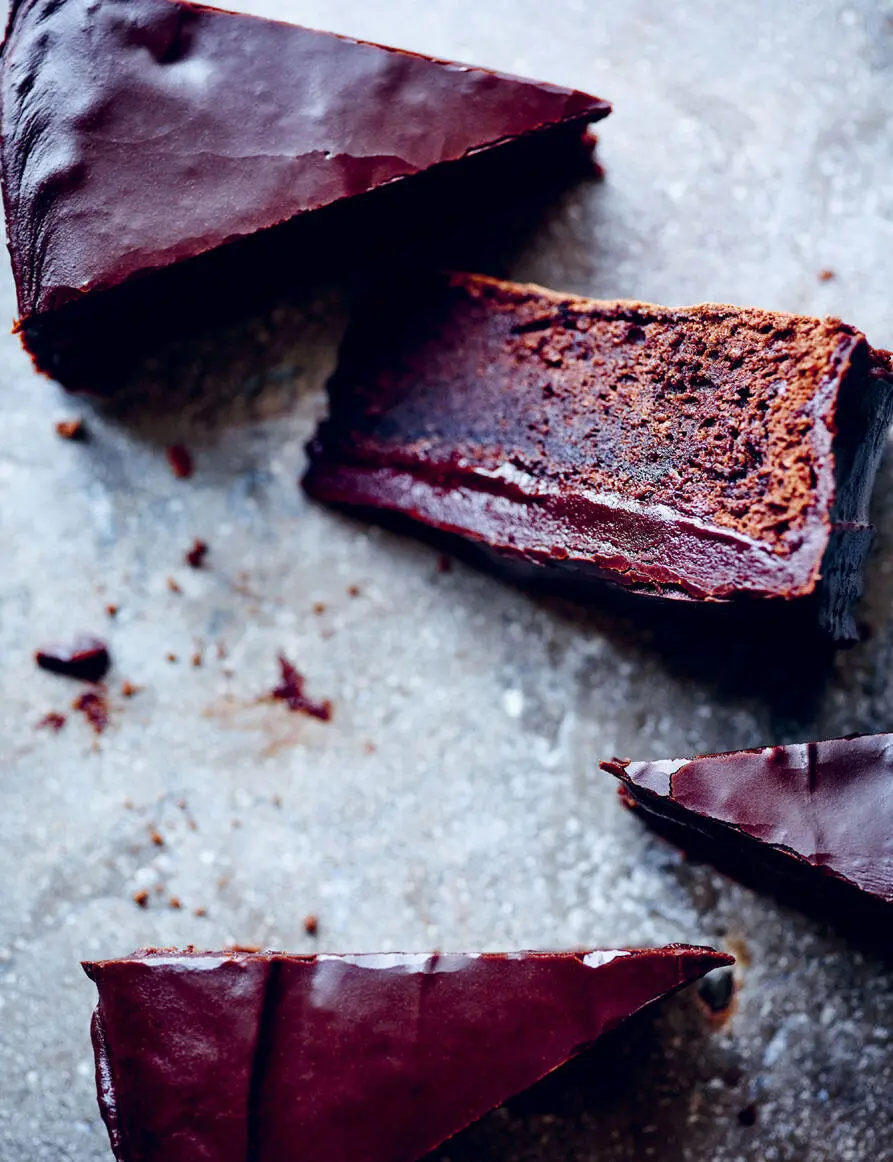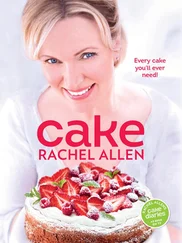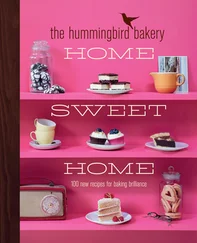4. Transfer the cake onto a plate or cake stand, and pour the glaze over the top, allowing it to drizzle down the sides. I like to decorate this for a celebration with crystallised rose petals.
Dodo’s Sachertorte
The mixture of dense chocolate cake, sweet apricot jam and that glossy, chocolate mirror glaze has made the Sachertorte a classic and much-loved dessert. This recipe is from Dodo, my fab brother-in-law. It takes a bit of time, but it’s worth the effort.
Serves 10–12
150g (5½oz) butter, soft at room temperature, plus extra for greasing
½ vanilla pod
125g (4½oz) icing sugar
6 eggs, separated
125g (4½oz) dark chocolate, (55–62% cocoa solids), roughly chopped
100g (3½oz) caster sugar
150g (5½oz) plain flour, plus extra for dusting
200g (7oz) apricot jam whipped cream, to serve
For the chocolate glaze
200g (7oz) caster sugar
200g (7oz) chocolate (55–62% cocoa solids), roughly chopped
24cm (9½in) springform cake tin
1. Preheat the oven to 170°C (325°F) Gas mark 3. Grease the side of the tin, and line the base with baking parchment. Scrape out the seeds from the vanilla pod and put in a large bowl. Add the butter and icing sugar, and cream with a wooden spoon until soft, or use an electric beater on slow. While continually mixing, add the egg yolks one by one to make a thick, creamy paste.
2. Melt the chocolate in a heatproof bowl over a pan of gently simmering water, making sure the base of the bowl doesn’t touch the water, and stirring regularly. Leave to cool.
3. Use a spatula to scrape out the chocolate into the mixture in the bowl. Stir into the mixture using a wooden spoon, or with the mixer on slow. Set aside and wash the mixer blades for the next step.
4. Put the egg whites into a clean, grease-free bowl and add the caster sugar. Whisk with an electric beater until they form stiff peaks, or use a food processor. Put the egg white mixture into the first bowl and sift the flour over the top. Gently fold into the ingredients in the bowl using a wooden spoon until fully mixed together.
5. Pour the mixture into the prepared tin and gently even it out with the back of a wooden spoon. Bake for 45 minutes, turning the cake half a turn after 30 minutes. It’s ready when a skewer inserted into the centre comes out clean.
6. Leave the cake to cool completely in the tin on a wire rack. Remove from the tin and remove the paper. Carefully transfer to a serving plate or cake stand.
7. Gently dissolve the apricot jam in a small saucepan over a medium-low heat. Stir the jam and brush a thin layer all over the sides and top, then leave it to absorb into the cake.
8. Meanwhile, to make the chocolate glaze, put the sugar and 100ml (3¼fl oz) water in a small saucepan over a medium-high heat and bring to the boil. Boil for 5–7 minutes, then leave to cool.
9. Put the chocolate in a heatproof bowl over a saucepan of water and melt as before. Once melted, add the sugar syrup a little at a time, constantly stirring with a spatula or wooden spoon. It will try to thicken, so keep stirring and adding the syrup until it has a shiny, slightly thick, liquid appearance.
10. You need to work quickly at this stage, as the glaze needs to be poured over the cake while still warm. Starting at the edges and working inwards in a circular motion, and using the glaze in the bowl, brush it on to the sides of the cake and level any unevenness on the top with as few movements as possible. Allow the glaze to cool and harden. Serve with cream.

Ombré cake
Here is another of my friend Pam Black’s creations. The ombré effect for icing is a simple idea but it makes an impressive-looking cake. If you are already nifty with a palette knife to ice cakes, this one is not too much of a stretch further. A turning icing table comes in handy, but alternatively you can use an upturned plate to put the cake on while you ice it. Pick whichever colours you like: go bright and pretty for a child’s birthday, or keep to chocolates, caramels and vanillas for a more sophisticated look.
Serves 10–12.
225g (8oz) butter, softened, plus extra for greasing
225g (8oz) caster sugar
4 eggs
1 tsp vanilla extract
225g (8oz) plain flour
1 tsp baking powder
2 tbsp milk, if needed
For the filling and topping
2 × quantity Classic Buttercream Icing
your choice of food colouring
your choice of fresh edible flowers or edible decorations
four 20cm (8in) sandwich tins
1. Preheat the oven to 180°C (350°F) Gas mark 4. Grease the sides of the tins, and dust lightly with flour, then line each base with baking parchment. Put the butter in a large bowl and cream it with a wooden spoon until soft, or use an electric beater on slow or a food processor. Add the sugar and beat it until light and fluffy.
2. Beat in the eggs and vanilla extract a little at a time, adding 1 tablespoon flour each time and beating well after each addition.
3. Sift in the remaining flour and the baking powder and fold in to combine, then add a little milk if needed to give a dropping consistency.
4. Spoon the batter into the prepared tins and spread evenly. Bake for 20–25 minutes until well risen, golden brown and springy to the touch. Leave the cakes to cool in the tins on a wire rack for 5 minutes, then turn them out on the rack to cool completely. Once cool, trim the tops off the cakes so that they are level.
5. Split the buttercream icing into four bowls. Use the food colouring to tint three of the bowls: one a pale colour, one medium and one a deep shade of the same colour.
6. Sandwich the cake layers on top of one another using the plain icing. Use a palette knife to cover the sides of the bottom third of the cake using the deepest colour icing. Cover the centre third with the medium icing, then spread the top third and the top of the cake with the pale icing.
7. Warm a clean, palette knife in boiling water, then run it around the cake sides to smooth out and blend the colours. Decorate the cake with flowers or as you prefer.
Mary Jo’s tres leches cake
Mary Jo McMillin is the most wonderful cook and a great friend of everyone at Ballymaloe. She comes regularly from her home town of Chicago to spend time at the Cookery School and we all swap inspiration. This is Mary Jo’s version of the famous three-milks cake: rich, yet not heavy, and completely delicious.
Serves 8–10
butter for greasing
150g (5½oz) plain flour, plus extra for dusting
5 eggs
1 tsp vanilla extract
150g (5½oz) caster sugar
For the filling and topping
225ml (8fl oz) fresh double cream
1 × 400ml (14fl oz) tin sweetened condensed milk
110–175ml (4–6fl oz) whole milk
1½ tsp vanilla extract
2 tbsp Grand Marnier or Cointreau (optional)
300ml (11fl oz) whipping cream
½ tbsp caster sugar
175g (6oz) raspberries
two 20cm (8in) cake tins; piping bag and medium star nozzle
1. Preheat the oven to 180°C (350°F) Gas mark 4. Grease the sides of the tins, and line the bases with baking parchment, then dust the sides with flour. Put the eggs, vanilla and sugar in a large bowl and whisk on high speed using an electric beater for 5 minutes until the mixture is pale and mousse-like.
2. Sift in the flour, then fold in thoroughly but lightly to retain the volume. Quickly divide the mixture between the two prepared tins and put in the centre of the oven to bake for 20–25 minutes until golden and a skewer inserted into the centre comes out clean. Cool the cakes in the tins on a wire rack for 2 minutes, then carefully turn out from the tins and remove the paper. Leave to cool completely.
Читать дальше













